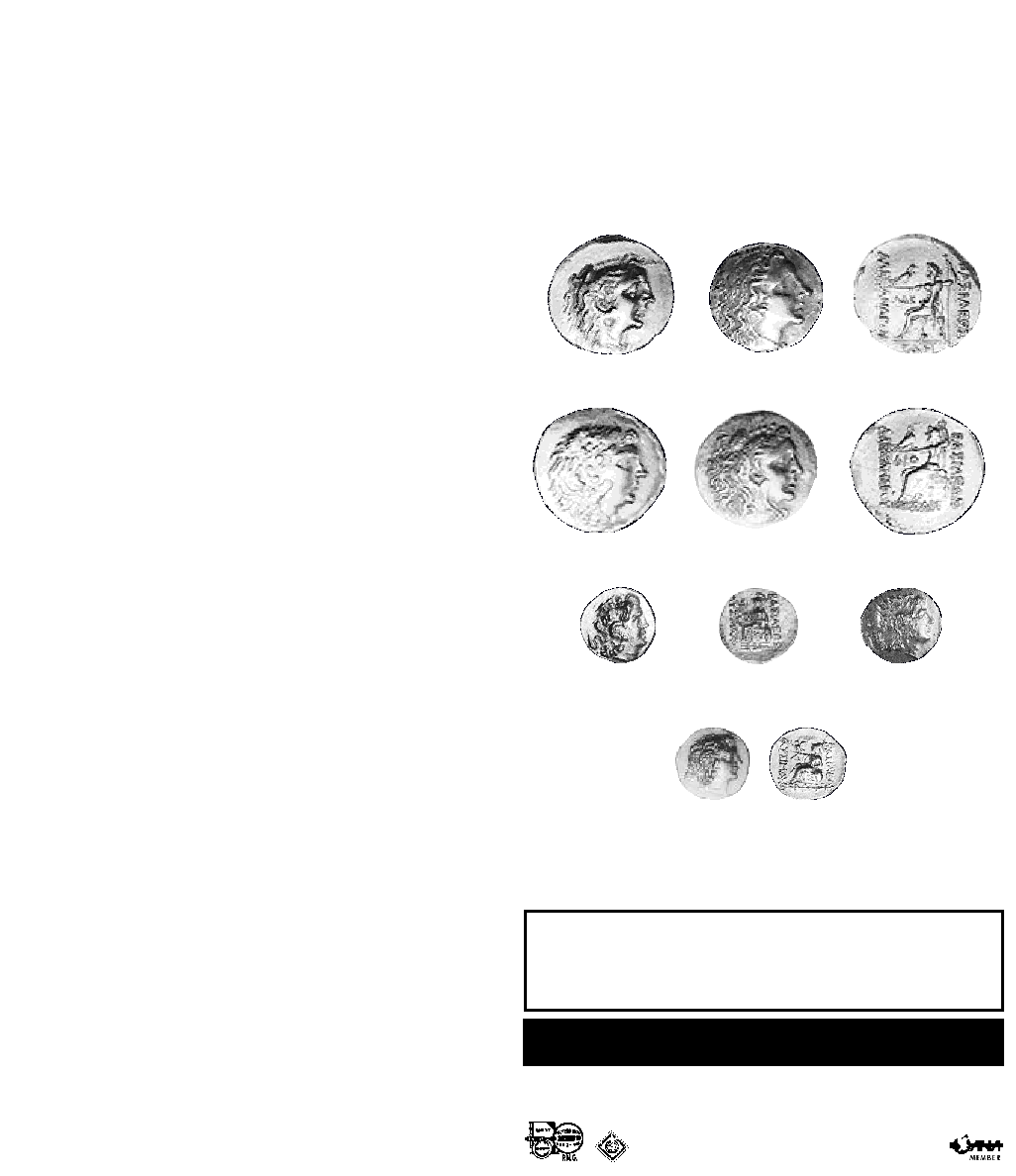
represent the war chests of the Greeks in their last stand against the expanding
Roman world. The silver coins weigh about 16 grams on generally large diameter
flans and the gold about 8.25 grams and were struck at various Black Sea cities
held by the Greek forces of Mithradates. At first glance all the Tetradrachms are
in the name of Alexander the Great, whose coin designs had been kept alive for
over 200 years by a large number of cities which had been part of his far flung
empire. The obverse features Hercules wearing a lion's skin headdress and the
reverse shows Zeus enthroned, holding his eagle and sceptre. The continuance
of coins in the name of Alexander served a variety of purposes. These coins
honored the gods Hercules and Zeus, as well as commemorating the great
Alexander himself. Likewise, the gold Staters are in the name of Lysimachos,
general of Alexander the Great and his treasurer, and they depict the famous
portrait of the deified Alexander as the god Ammon. The reverse honors the
goddess Athena, armored and enthroned. The metallic reputation of these widely
accepted trade coins shined through the centuries. There are historical accounts
of these Greek cities being surrounded by the barbarians. They would threaten to
attack if not paid their tribute in "Alexanders." Mithradates implemented the next
use of these silver "Alexanders" by placing his own portrait, wearing the lion's skin
headdress of Hercules on the obverse. The gold Staters from the Tomis mint are
believed by some to show Mithradates' features as the immortal Alexander.
Perhaps his megalomania made him really believe he was Hercules or Alexander,
or maybe this identification with a god and hero was simply to inspire his armies.
the mantle of Alexander the Great and unite all Greek speaking peoples in a
crusade against the rising power of Rome. Mithradates' own career was the stuff
of legend. Born around 120 B.C., he inherited at age 11 the kingdom of Pontus,
a small, rather unimportant realm on the south coast of the Black Sea. However,
his ferocious mother seized power, forcing Mithradates and his entourage to flee
to the mountains. There he grew into a man of power and insatiable appetites. He
received an advanced Greek education and could speak 25 languages. He was
also a large, exceptionally strong, and skilled warrior. To thwart assassins he took
minute doses of poisons daily to build up immunities. At age 18 he returned to
Pontus, launched a counter coup and put his mother and brother to death. He
embarked on a career of conquest which brought most of the lands around the
Black Sea into his domain. The coins featured from these hoards were struck at
the Black Sea west coast trading centers of Mesembria, Istrus, Tomis, Kallatis and
Odessos.
and bankers swarmed everywhere and were universally detested. Mithradates
conceived a vision of liberating the East from Rome and winning himself an even
greater empire. He prepared for war by recruiting a huge army which he
unleashed in 88 B.C. in the First Mithradatic War. He began invading neighboring
kingdoms allied with the Romans, and by ordering the execution of every Roman
citizen in Asia Minor, over 80,000 Italians perished in "The Night of the Vespers."
Mithradates crossed over from Asia Minor to Thrace and south to Greece proper,
calling for a general insurrection against Rome. Athens welcomed him as a
liberator, but more far-sighted Greeks realized Mithradates was as ruthless as the
people he sought to replace, and that Rome would not be easily defeated. The
Roman response came in 87 B.C., led by the consul Sulla and five battle
hardened legions. Sulla recaptured Athens and pursued Mithradates back to Asia
Minor. Political discord in Rome forced Sulla to cut short his campaign, and in 85
B.C. he settled a peace with Mithradates. Mithradates had to evacuate his
annexed territories and return to Pontus, surrender his fleet of 70 war galleys and
pay a tribute of 2,000 Talents, or roughly 2.75 million of these silver Tetradrachms.
Thus ended the First Mithradatic War.
defeated Murena, and Sulla, still occupied in Rome, ordered the Romans to
withdraw. Some scholars date the Tetradrachm hoard to 83/82 B.C. coinciding
with this campaign. Mithradates continued rebuilding, and by 74 B.C. he had
barbarians, (who probably preferred to be paid in "Alexanders"). The Third
Mithradatic War swung back and forth until Mithradates was defeated by Pompey
the Great. An army mutiny led by Mithradates' own son, Pharnaces, sealed his
fate. In 63 B.C. after he ordered his harem of 500 slain, he attempted suicide by
poison, but his immunity worked too well, and Mithradates died on his own sword.
American Express accepted.
5. All coins sent insured or registered! Orders less than
Free photo certificates of authenticity available on request for orders over $500.